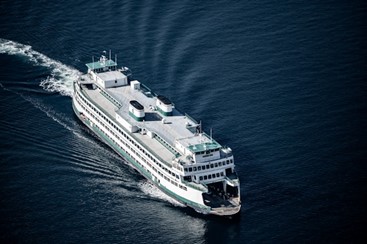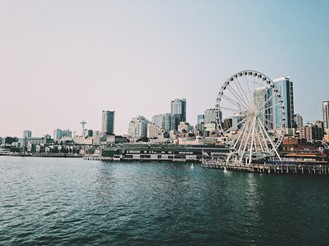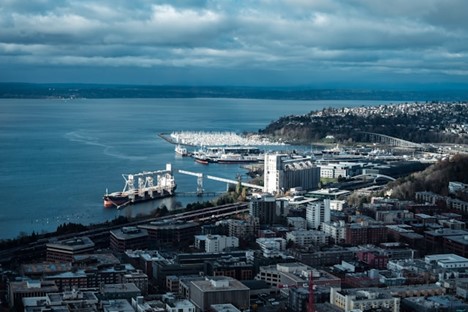Ryan Calkins is the Port Commissioner for the Port of Seattle, a government agency overseeing the seaport of Seattle, as well as Seattle–Tacoma International Airport. With an extensive portfolio that includes parks, waterfront real estate, and some of the largest container terminals on the West Coast, the Port of Seattle stands as a pivotal economic driver in the Pacific Northwest. In this article, Commissioner Calkins explores the critical elements and advantages of policy and regulatory frameworks designed to foster sustainable port operations.
The maritime industry, integral to global trade and commerce, has traditionally been associated with significant environmental impacts. Ports, as pivotal nodes in this industry, face the challenge of balancing economic growth with environmental sustainability. Effective policy and regulatory frameworks are essential in guiding ports towards sustainable practices. These frameworks not only ensure compliance with environmental standards but also foster innovation and collaboration among stakeholders.
Ryan Calkins Explains the Need for Sustainable Ports
Ports are bustling hubs of activity, handling the movement of goods, passengers, and energy resources. However, these activities can result in air and water pollution, habitat destruction, and significant carbon emissions. Sustainable ports, like the Port of Seattle, aims to mitigate these impacts by implementing practices that protect the environment while maintaining economic vitality. Achieving this balance requires a robust policy and regulatory framework that sets clear standards and encourages continuous improvement.
Key Components of Sustainable Port Policies
Environmental Regulations and Standards
Governments and international bodies establish regulations to control pollution and manage environmental impacts. Ryan Calkins, Port Commissioner says that these include limits on air and water pollutants, waste management protocols, and restrictions on ballast water discharge to prevent the spread of invasive species. The International Maritime Organization (IMO) plays a critical role in setting global standards, such as the International Convention for the Prevention of Pollution from Ships (MARPOL).
Emission Control Areas (ECAs)
ECAs are designated sea areas where stricter controls on sulfur and nitrogen oxide emissions from ships are enforced. Ports within ECAs must adhere to these stringent emission standards, often leading to the adoption of cleaner fuels and advanced emission reduction technologies.
Sustainable Development Goals (SDGs)
Ryan Calkins, Port Commissioner explains that the United Nations’ SDGs provide a comprehensive framework for sustainable development, including goals directly relevant to ports, such as SDG 14 (Life Below Water) and SDG 13 (Climate Action). Ports integrate these goals into their policies, ensuring alignment with global sustainability objectives.
Port-Specific Sustainability Plans
Many ports develop their own sustainability plans, tailored to their unique operational contexts and environmental challenges. These plans outline specific targets for reducing emissions, improving energy efficiency, enhancing biodiversity, and promoting social responsibility.
Regulatory Frameworks Promoting Sustainable Practices

National and Regional Legislation
Countries implement laws that regulate port operations and enforce environmental standards. For example, the European Union’s Port Reception Facilities Directive mandates ports to provide adequate waste reception facilities and ensures that ships do not discharge waste into the sea.
Incentives and Penalties
Governments and port authorities employ a mix of incentives and penalties to encourage sustainable practices. Ryan Calkins, Port Commissioner says that some of these incentives may include tax breaks, grants, and reduced port fees for vessels that comply with environmental standards. Conversely, penalties for non-compliance can be severe, including fines and restrictions on port access.
Green Port Certification Programs
Certification programs like the EcoPorts and Green Marine initiatives provide frameworks for ports to achieve and demonstrate environmental excellence. These programs offer guidelines, performance indicators, and third-party verification, helping ports to systematically improve their sustainability performance.
Public-Private Partnerships (PPPs)
PPPs facilitate collaboration between government entities, port authorities, private companies, and non-governmental organizations. These partnerships leverage diverse expertise and resources to implement sustainable projects, such as renewable energy installations, habitat restoration, and green infrastructure development.
Sustainable Policies at the Port of Seattle
The Port of Seattle, the largest and fastest-growing cruise market on the West Coast, has successfully implemented sustainable policies while generating $900 million in annual business revenue. Over 20 years, Ryan Calkins reports that the Port has prioritized environmental protection, aiming to be the cleanest and most energy-efficient port in North America.
Key Initiatives and Achievements
Water Quality Protection
- Voluntary Clean Water Agreement: The Port, cruise lines, and regulators maintain a unique agreement to protect water quality.
- Waste Management: Cruise ships follow rigorous solid waste and recycling programs, with a focus on reducing single-use plastics.
- Wastewater Discharge Prevention: Since 2004, a Memorandum of Understanding with the Washington State Dept. of Ecology prevents wastewater discharges from cruise ships.
- Stormwater Practices: Strict management practices are imposed for cruise vessels at berth.
- Exhaust Gas Cleaning: Since 2020, cruise ships are prohibited from discharging exhaust gas cleaning system wash water.
Air Pollution and Climate Change Mitigation
- Clean Air Strategy: Collaborating since 2008, the Northwest Ports Clean Air Strategy aims to eliminate air pollution and be carbon-free by 2050.
- Emission Reductions: Since 2005, diesel particulate emissions decreased by 84%, and greenhouse gas emissions by 17%.
- Emission Control Area: Ryan Calkins also notes that the Port supported regulations limiting sulfur content in fuels within 200 miles of the coast, significantly reducing emissions.
- Shore Power: Clean shore power is provided at two cruise berths, with plans to extend to all berths by 2023. The goal is a 100% shore power connection rate by 2030.
- Zero-Emission Equipment: Over 90% of cargo-handling equipment is powered by electricity or propane.
- Clean Energy Strategic Plan: The Port is developing a plan to deploy zero-emission infrastructure, including shore power.
Economic Impact
- Economic Contributions: The cruise industry supports over 5,500 jobs and generates nearly $900 million in revenue during typical operations.
- World-Class Facilities: The Port can handle large vessels with its deep-water port and award-winning facilities, conveniently located near Seattle’s waterfront attractions and airport.
In 2022, the Port joined 14 organizations to create the world’s first cruise-focused Green Corridor, exploring decarbonization strategies from the Pacific Northwest to Alaska. This comprehensive approach showcases the Port of Seattle’s leadership in sustainable port operations.
Benefits of Sustainable Port Policies

Environmental Protection
Effective policies and regulations significantly reduce the environmental footprint of port operations. Ryan Calkins, Port Commissioner explains that cleaner air and water, reduced greenhouse gas emissions, and preserved biodiversity are direct benefits of sustainable port practices.
Economic Competitiveness
Sustainable ports are often more efficient and resilient, enhancing their competitiveness in the global market. Investments in green technologies and infrastructure can lead to cost savings and open new business opportunities.
Social Responsibility
Ports that prioritize sustainability contribute to the well-being of surrounding communities by reducing pollution-related health risks and creating green jobs. Engaging with local stakeholders ensures that port development aligns with community needs and values.
Regulatory Compliance and Risk Management
Ryan Calkins, Port Commissioner says that the proactive adoption of sustainable practices helps ports stay ahead of regulatory requirements, avoiding costly penalties and legal issues. This forward-thinking approach also mitigates risks associated with environmental incidents and climate change impacts.
Conclusion
Policy and regulatory frameworks are vital in steering ports towards sustainability. By setting clear environmental standards, providing incentives for green practices, and fostering collaboration among stakeholders, these frameworks ensure that ports can operate efficiently while safeguarding the environment. Ryan Calkins, Port Commissioner says that as the global demand for maritime trade continues to grow, sustainable port policies will play a crucial role in achieving a balance between economic development and environmental stewardship. The successes of ports like Los Angeles, Rotterdam, and Singapore demonstrate that with the right policies in place, ports can thrive sustainably, setting a benchmark for the rest of the industry to follow.












